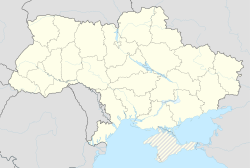Kolky (urban-type settlement)
Kolky | |
|---|---|
 Flag  Coat of arms | |
 Kolky | |
| Coordinates: 51°06′N 25°41′E / 51.100°N 25.683°ECoordinates: 51°06′N 25°41′E / 51.100°N 25.683°E | |
| Country | |
| Province | |
| District | Manevychi Raion |
| First mentioned | 1545 |
| Population (2021) | |
| • Total | 3,979 |
| Time zone | UTC+2 (EET) |
| • Summer (DST) | UTC+3 (EEST) |
Kolky (Ukrainian: Колки), also Kolki (Yiddish: Kolki, Polish: Kołki, Russian: Колки, Hungarian: Kolke) is an urban-type settlement in the Volyn Oblast in Ukraine, located in the historic region of Volhynia. Kolky has a population of 3,979 (2021 est.)[1]
Kolky is located on the confluence of the Styr and Rudka rivers, 51 kilometres north-east of Lutsk.
History[]
Grand Duchy of Lithuania 1545–1569
Polish–Lithuanian Commonwealth 1569–1795
Russian Empire 1795–1917
Second Polish Republic 1919–1945
Soviet Union 1939–1941 (occupation)
Nazi Germany 1941–1944 (occupation)
Soviet Union 1944–1945 (occupation)
Soviet Union 1945–1991
Ukraine 1991–present

First time mentioned in 1545. The place has the urban-type settlement status since 1940.
The Jewish population was important before World War II, around a third of the total population (724 members in 1921, 860 in 1937).[2] The German army occupied the city at the end of 1941. 50 Jews were murdered by the Ukrainian police during the summer of 1941.[3] In October 1941, Jews were forced to live in a ghetto. In July 1942, the Jewish population was massacred by an Einsatzgruppen of Germans, members of Sicherheitsdienst and Gendarmerie and by Ukrainians, members of the local police.[4][5]
Also local Polish population fell victim to genocide. On June 13, 1943, dozens of Poles were burned alive in the local Catholic church by the Ukrainians as part of the genocide of Poles in Volhynia.[6]
The heraldry and the gonfalon are adopted in 1997. The bell is a symbol of the defensive role of the city throughout history. The linaceae is a local resource.[citation needed]
Notable people[]
- Tadeusz Piotrowski, Polish mountaineer, was born in Kolki
- Family of Esther Safran Foer, writer and mother of Jonathan Safran Foer
See also[]
References[]
- ^ "Чисельність наявного населення України (Actual population of Ukraine)" (PDF) (in Ukrainian). State Statistics Service of Ukraine. Retrieved 11 July 2021.
- ^ "Technical Problem Form". data.jewishgen.org.
- ^ "YAHAD - IN UNUM". yahadmap.org.
- ^ http://www.yadvashem.org/yv/he/research/ghettos_encyclopedia/ghetto_details.asp?cid=900#!prettyPhoto
- ^ "Kołki - Virtual Shtetl". www.sztetl.org.pl.
- ^ [1]
External links[]
- (in Russian) Official website[permanent dead link]
- (in Russian) Topographic map
- (in Ukrainian) Road map
- Kolky, Ukraine at JewishGen
- Urban-type settlements in Volyn Oblast
- Holocaust locations in Ukraine

